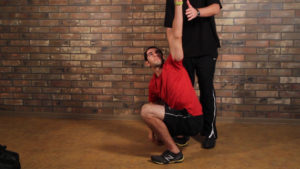by Mitch Hauschildt, MA, ATC, CSCS
“You’ve got to be very careful if you don’t know where you are going because you might not get there.” -Yogi Berra
Performing a great evaluation might be the most important part of training athletes and the general population alike. It can be tempting to skip over the evaluation process and just go to work training people. But, if you do that, you are making a huge mistake and putting your clients, and ultimately your professional career, on the line. It is really that important.
If we don’t understand our clients or athletes, how do we really know what they need? It leads us to blindly throwing them exercises and hoping it helps them. Unfortunately, there are still a number of clinicians, coaches, and instructors who don’t understand basic fundamental movement patterns. Being able to evaluate someone’s ability to squat, lunge, press, pull, and rotate efficiently should always be done first, before moving on to other training or rehab programming.
“It is much harder to detect the subtleties of compensatory movement in the early stages although easier to correct them, and much easier to detect errors in chronic movement dysfunction however they are much more difficult to change.” – Evan Osar
Evan Osar’s statement says a lot about the importance of evaluating movement. If we can use a good, sensitive screening tool and we are detailed in our evaluation process, we can detect the smaller, more subtle movement flaws. Then we will be able to correct them before they become large, deeply engrained movement dysfunction. Without a quality evaluation tool, you will never be able to detect their dysfunction early, when it is most easily corrected.
On the other hand, all of us have had clients with very obvious dysfunction. These are the clients who can’t squat below 70 degrees of knee flexion or rotate their thoracic spine more than 15 degrees in either direction. With those clients, it can be easy to say, “I don’t need a screen to tell me they can’t squat! I can see that.” The error in that thinking is, while we know what they can’t do, we don’t really know why without looking into it further. A poor squat can occur because of a number of different reasons. A good evaluation tool will help you find them.
Evaluation Tools
Today there are multiple quality movement assessment tools readily available to you. We aren’t here to promote or endorse any of them. All of them have their strengths and weaknesses and do a fine job at hitting their intended target. You can also feel free to develop your own evaluation tool if you feel confident in your ability to understand and evaluate movement patterns in that manner.
Our recommendation is that whatever evaluation or assessment tool you choose to use, that you learn it well and use it often.
“Pain affects motor control in unpredictable and inconsistent ways. This, coupled with poorly planned and poorly reproduced exercises, gives patients little chance of reestablishing authentic motor control.”
– Gray Cook
Screening should be performed in the absence of pain. If anything that you are doing in your screening process (whatever that is) elicits pain, they should immediately be referred to the proper medical professional for a full evaluation and follow up care. Once they are pain free and cleared for activity, they should begin again with a full screen and corrective exercise based on their needs at that time.
Then it is time to use the information collected and get to work. Make people stronger, more stable, more resilient and happier. Help them fall in love with moving efficiently so they can move more frequently.


Leave a Reply